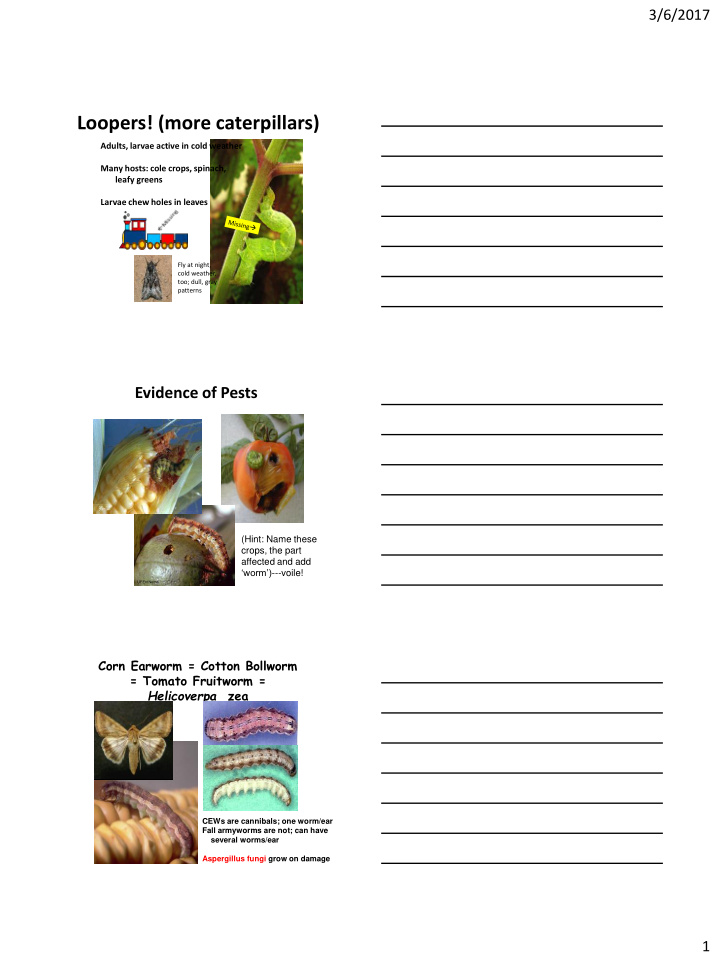



3/6/2017 Loopers! (more caterpillars) Adults, larvae active in cold weather Many hosts: cole crops, spinach, leafy greens Larvae chew holes in leaves Fly at night, cold weather, too; dull, gray patterns Evidence of Pests (Hint: Name these crops, the part affected and add ‘worm’) ---voile! UFEntNema Corn Earworm = Cotton Bollworm = Tomato Fruitworm = Helicoverpa zea CEWs are cannibals; one worm/ear Fall armyworms are not; can have several worms/ear Aspergillus fungi grow on damage 1
3/6/2017 Corn Earworm/Tomato Fruitworm Management Smothers CORN TOMATOES eggs • Smear oil on • Spray plants & ‘fresh’ silks fruit several times with BT* as • Spray ‘fresh’ silks, Paralyzes gut; die needed later shuck ends with Affects ONLY BT* several ‘worm stage! • BT = Bacillus thuringiensis kurstaki ; times toxin produced by this commercially grown soil bacteria will kill many common caterpillar pests 4 • Dipel, Thuricide, Biobit, others are Evidence of Pests Difficult to detect Major damage can occur over night! Tomato (& Pepper) Hornworm Life Cycle-clockwise Hand pick or BT frequently 2
3/6/2017 Management Tactics for Hornworms Hand-pick while scouting, weeding BT or Pyrethrin sprays: work best on small worms More Evidence of Pests Phyllotreta cruciferae CO State Univ, bugwood.org Epitrix cucumeris WCranshaw, CO State Univ, bugwood.org Systena blanda WCranshaw, CO State Univ, bugwood.org Epitrix tuberis WCranshaw, CO State Univ, bugwood.org Flea Beetles ---More Hole Makers Systena blanda , WCranshaw, CO St Univ bugwood.org Epitrix tuberis , ACushman, USDA SEL, bugwood.org Adults often shiny metallic colors; Epitrix cucumeris Hannah Royals USDA APHIS ITP bugwood.org 1-3 mm long. JUMP! Larvae can burrow into stems, tubers, etc. 3
3/6/2017 Managing Flea Beetles Incorporate organics Weed control=harborage Mulches=hiding places (don’t leave on surface) Insecticides? ~~control. Damage usually worst on older leaves, especially early in season. a Azadirachtin, oils, soaps, pyrethrins labeled. Spinosad may help, but may kill beneficials. Evidence of Pests Hosts susceptible between germination & flowering Summer squash can be affected Leaves wilt first, then stems, then whole plant Plants ‘recover’ at night but wilt again Death often occurs in 7-14 days Spotted Cucumber Beetle Features of Adult Beetle - abt. ¼” long; soft, elongated oval body -thorax & wing covers shiny green -6 black spots on each wing cover -antennae, legs and head black Transmits bacterial wilt & cucumber mosaic virus BW survives inside adults overwintering in weeds & debris around field Management Strategies Grow cultivars selected for resistance to BW No weeds year long; eliminate field debris at end of season (harborage) Row covers from germination to bloom (remove for pollination!) 4
3/6/2017 Remember: New Pests May Appear 1-Brown marmorated stink bug 2-Bagrada Bug (cole crops) 1 2 3-African Cluster Bug (mints) 3 4-Tomato/potato psyllid 4 5-Sage/Mint Leafhopper And more!!! 5 Are There Any Beneficial Insects? (Yes, and many are natives) Still, you need to know your pests. Some might be ordered to augment natural populations. 14 Spiders: Under-appreciated Predators Generalists---Accept Them 5
3/6/2017 Predatory Mites---Think VERY Small (If prey levels drop too much, some of these can die out; be prepared to monitor these as well as pests) Neoseiulus sp. for thrips Some occur naturally; some can be purchased Hypoaspis sp. Neoseiulus sp. on spider mite Phytoseiulus sp. (arbico.com) Predatory Bugs: Various Natives Minute Pirate — tiny, aggressive* Damsel---occasionals Big-Eyed Predatory Stink ( Podisus ) ---larger, occasional Assassins--- Green Lacewings: Valuable! Adult---abt ½” long; pale green, eyes Metallic gold or copper; weak flyer Eggs---pin-head size, white, on ‘soft’ pogo -sticks Larvae---alligator shaped, long, hollow jaws, very Can be locally active hunters; can’t travel common; also, can be ordered. Order Neuroptera 6
Recommend
More recommend